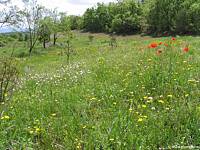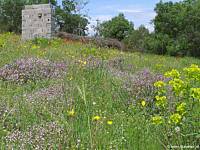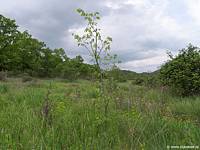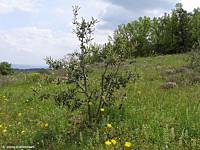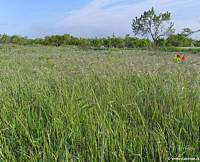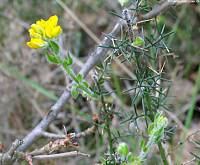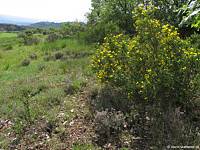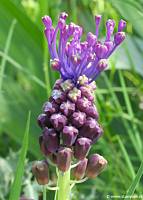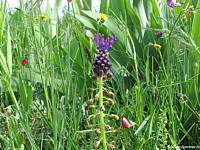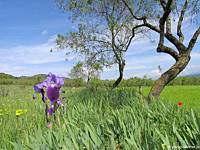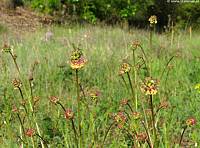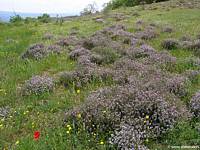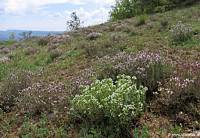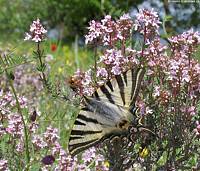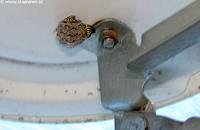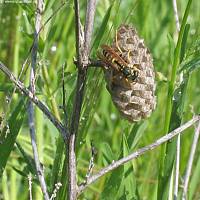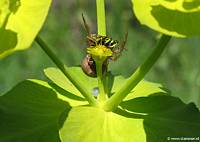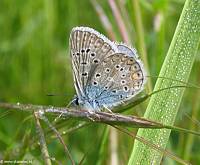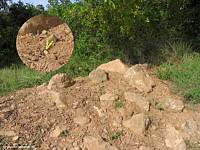|
|
Nature
Switched On
|
|
|
introduction |
2007 April 28, 29 & 39, from Saturday to Monday With temperatures around 20º
and now and then a heavy shower (during one of them we collected 19
litres of rain in less than 2 hours) the conditions had been optimal
for vegetation growth. The aspect of the terrain was indeed
wonderful when we arrive
|
Looking south-east on the higher terrace. Red poppies, White Rockrose, Catsear and shrubs of Dogrose and Kermes oak. Sunday 12:53 |
|
Same terrace, looking north-west. Common Thyme,
Cypress Spurge, and Catsear. |
||
|
The trees were budding and getting a fresh green colour and I
discovered many more seedlings of trees and shrubs. I am really
questioning the necessity of planting any more of them. Planting
involves some minor
The Kermes Oak (Quercus coccifera) had endured well the pruning in winter and most of the specimen showed a vigorous sprouting.
|
||
| European
Nettle Tree. Looking north-west on the lowest terrace. Saturday 13:55 |
||
| Kermes Oak. Looking south-east in the centre of the terrain | ||
|
Thanks to all the flowering I was able to confirm and correct the
A
Also limited to the SW of Europe is this other member of the same family Cytisophyllum sessilifolium, quite an ornamental shrub without the thorns typical of many close cousins.
This strange flower is Tassel Hyacinth (Muscari
comosum), a Mediterranean
species having sterile bluish-violet flowers forming a tuft above
the fertile flowers. From the same genus as Common Grape
Hyacinth (Muscari neglectum) it grows from a
thick reddish bulb
|
||
|
Field of Bromus
diandrus in the lower western part. Monday 8:55 |
||
| Spanish
Broom in the shade of the woodland border. Sunday 12:38 |
||
|
Cytisophyllum
sessilifolium on the lowest terrace. Looking south-east. Sunday 11:02 |
||
| Tassel hyacinth accompanied by German iris, Vicia peregrina, Lathyrus setiflolius, Bromus diandrus and Catsear |
Close up of Tassel Hyacinth. Sunday 11:11 |
|
|
The origin of the German Iris (Iris
germanica) is uncertain but it invaded the mayor part of
southern Europe centuries ago with its rhizomous roots. It is so
ornamental that it can almost be considered a 'weed' in this wild
and native garde The photograph on the right shows the very first flowering of Salad Burnet (Sanguisorba minor) one of the most abundant species on the terrain. |
||
|
German Iris on the lower western terrace with the almond trees.
Looking north-west. Sunday 11:14 |
||
|
Salad Burnet, on the lower
central terrace. Monday 9:37 |
||
|
The flowering of Common thyme (Thymus vulgaris) is spectacular and attracts loads of different insects especially bees.
|
||
|
Field of Common Thyme on the higher, central terrace. Saturday 13:25 |
'Albino' Common Thyme. Sunday 12:30 |
|
|
Scarce Swallowtail (Iphiclides podalirius) on a
shrub of Common Thyme. Sunday 13:07 |
||
|
No surprise that our caravan would also experience the invasion
zeal of wildlife. This wasp nest had been constructed during the
course of one week on the roof window of the caravan. Similar nest
could be found outside a
Impossible of course to give all the insects a proper treatment on
these pages. I will limit myself to the occasional snapshot of
beautiful and/or curious phenomena of which here there are some
examples. |
||
|
Wasp nest in the caravan. Saturday 20:45 |
||
|
Wasp nest on the stem of Rush
Skeletonweed. Sunday 10:23 |
||
|
Duel between spider and wasp on the flower of a Cypress Spurge. Sunday 13:15 |
||
|
Polyommatus
bellargus on Bromus diandrus. Monday 9:53 |
||
|
The many stone groups have now been planted with Sedum and Sempervivum species I collected from our terrain (Sedum sediforme) or from a neighbour's garden (Sedum album, Sedum acre, Sedum dasyphyllum, Sempervivum tectorum). With these plants we hope to have a good starting collection for the planting of the 'green roof' of our future house. Partly for this reason I will violate the law 'Thou shall not weed' in a wildlife garden, because especially the stone groups on the lower terrace with deeper and richer soil will soon be invaded by Goosefoot, Whitetop and Wild Buckweed. |
||
|
Stonegroup at the entrance to
the terrain in the west. In the inlay a detail of Sedum
acre and Sedum album. Monday 9:56 |
||
|
introduction
|
|
|
